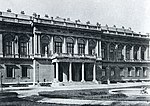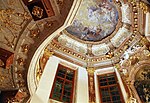Palais Miller von Aichholz
Austrian building and structure stubsBuildings and structures demolished in 1961Palace stubsPalaces in Vienna
Palais Miller von Aichholz was a city-palace (Palais) in Vienna, Austria. It was constructed for the noble Miller von Aichholz family and later bought by the Jewish aristocrat Camillo Castiglioni. Therefore, the building was later known as Palais Castiglioni. The owner was forced to flee after the Anschluss of Austria to Nazi Germany in 1938 and became property of the city of Vienna. It was subsequently demolished in 1961.
Excerpt from the Wikipedia article Palais Miller von Aichholz (License: CC BY-SA 3.0, Authors).Palais Miller von Aichholz
Prinz-Eugen-Straße, Vienna Wieden (Landstraße)
Geographical coordinates (GPS) Address Nearby Places Show on map
Geographical coordinates (GPS)
| Latitude | Longitude |
|---|---|
| N 48.194166666667 ° | E 16.3775 ° |
Address
Plößlgasse
Prinz-Eugen-Straße
1030 Vienna, Wieden (Landstraße)
Austria
Open on Google Maps










